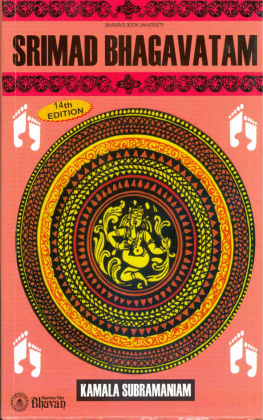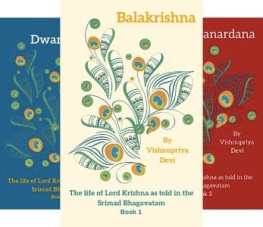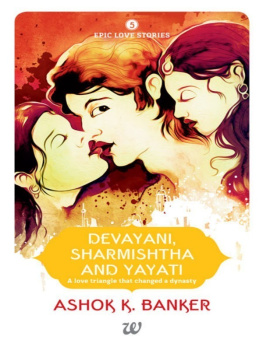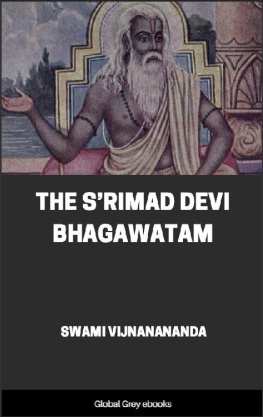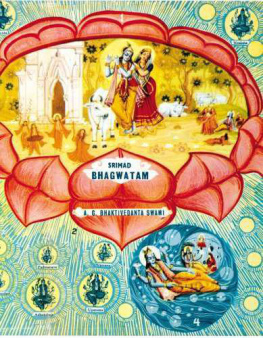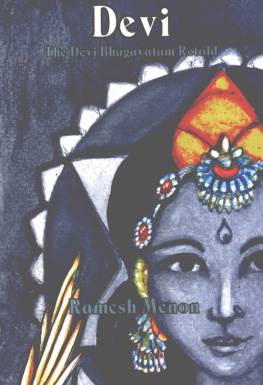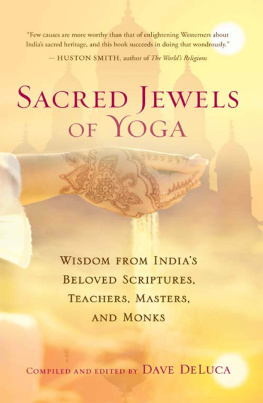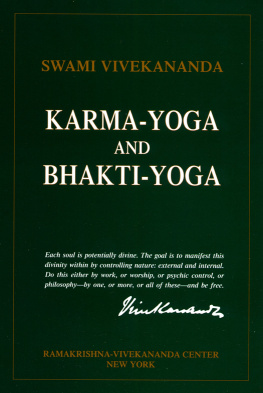SRIMAD BHAGAVATAM
By
Kamala Subramaniam
All Rights Reserved
Bharatiya Vidya Bhavan
Kulapati Munshi Marg
Mumbai 400 007
st Print Edition: 1979
nd Print Edition: 1981
rd Print Edition: 1987
th Print Edition: 1988
th Print Edition: 1993
th Print Edition: 1995
th Print Edition: 1997
th Print Edition: 2003
th Print Edition: 2006
th Print Edition: 2008
th Print Edition: 2010
th Print Edition: 2012
th Print Edition: 2013
th Print Edition: 2015
Kindle Edition: 2016
PRINTED IN INDIA
Bharatiya Vidya Bhavan,
Mumbai 7.
Let noble thoughts come to us from every side
-Rigveda 1-89-i
SRIMAD BHAGAVATAM
By
Kamala Subramaniam
2016
BHARATIYA VIDYA BHAVAN
Kulapati K. M. Munshi Marg,
Mumbai 400 007
FOREWORD
This is a summarised version of the Mahapurana Srimad Bhagavatam written by Smt. Kamala Subramaniam. Earlier Smt. Subramaniam had brought out a condensed version of the great epic Mahabharata also which became very popular and was highly valued by the society at large.
While summarising the Mahapurana, Smt. Subramaniam has omitted only the ornamentations and decorations, usual in all Sanskrit literature. She has uncompromisingly kept intact the solid hard core of the Mahapurana. Not only she has taken no liberty with the essentials of this sacred book, but in fact has brought them out more prominently in a language which is as simple as it is appealing. The readers of this sacred book will thus derive great spiritual benefit not confined to the Hindu society alone but also to mankind outside the Hindu fold.
While studying the Kathas - the stories of the great personalities and of the avataras and the parables - the reader as he reads the passages should amply digest them to know the true purport of the suggestions, the lessons and the indications behind them. These are not just embellishments. They have a deep meaning under the surface. Attentive study of these shall spiritually inspire the reader more than the Kathas themselves.
It is not my desire not it is desirable to make any comments on the content and object of this Mahapurana. Such an effort on my part shall deprive the reader from drinking the joyful nectar which the original text contains in an adequate measure. Let the reader read the summarised version and if attracted also the unabridged Grantha , digest and reflect and draw inspiration therefrom to mould his life and achieve the spiritual bliss and tranquility which is the ultimate goal of all the pilgrims of life the Jeevan Yatra.
The story goes that even after composing the Mahabharata Vyasa was not completely happy. On relating his dissatisfaction to the sage Narada, Vyasa was told that his restlessness was due to the fact that while in Mahabharata he fully propagated Karma Yoga, he neglected Bhakti Yoga and that he should write something more in the glory of Narayana, which alone shall give him the full mental tranquility. It was at this suggestion of the sage Narada that Vyasa compiled Srimad Bhagavatam .
The general impression that Bhagavatam is purely a Purana of Bhakti Yoga therefore is not unnatural. But on proper appreciation of the Mahapurana, we shall discover that while Bhakti does dominate, Jnana and Karma have not been neglected in Bhagavatam . To put it correctly the Mahapurana is the Sangam Confluence the Triveni of the three streams of Bhakti Yoga, Karma Yoga and Jnana Yoga. It is thus the Samanvya , the Samuchhya , of all the three paths.
This Samanvya is beautifully brought out by the Lord in Gita, Chapter IV, Stanza 10, where he states:
vita-raga-bhaya-krodha man-maya mam upasritah
bahavo jnana-tapasa puta mad-bhavam agatah
" A Karma yogin free from attachment, fear and anger, a Bhakta absorbed in Me, taking refuge in Me.' a Jnana yogin 'purified by the fire of knowledge' with these qualifications of Karma yoga, Bhakti yoga and Jnana yoga many have attained My Beings."
As described in Gita so also in Srimad Bhagavatam this Samanvya finds a prominent place.
May God bless the readers of this Mahapurana.
My congratulations and Sadhu Vada to Smt. Kamala Subramaniam for this Punyakarya - a virtuous and meritorious act.
May God bless her.
G.D. BIRLA
PREFACE
Aum Namo Bhagavate Vasudevaya
Some years back, I made an attempt to narrate the story of the Mahabharata . I must say that I succeeded to an extent in my attempt and the book was published under the aegis of Kulapati Shri K. M. Munshi.
My thoughts were then turned towards Sri Bhagavatam . To many people the Bhagavatam signifies only Krishnavatara. In several pravachanas I have heard, only the tenth canto has been dealt with in great detail and the talk ends invariably with the wedding of Krishna with Rukmini and that is the end of it.
There are quite a few, however, who are familiar with the ten avataras of the Lord: Matsya being the first and Kalki, the last. But then, there are many more avataras - descents - of Lord Narayana down to the earth during the three yugas. I was eager to tackle this great Purana and try to make young minds familiar with it.
Right from the beginning one fact was clear. Sri Bhagavatam is entirely different from Mahabharata. There is continuity in the Mahabharata , in the story, which makes the narration comparatively easy. On the other hand, the Bhagavatam is made up of a number of isolated stories, incidents and innumerable episodes. There is no continuity here to hold the attention of the reader.
I was at a loss as to how I should begin. There are several places where one can say: "This is the beginning." The Bhagavatam is repeated from mouth to mouth and it is related to different people by different preceptors. It is a confusing, tantalising, labyrinth where one easily gets lost. And again, since Bhakti is the central theme, there are numerous passages where the praises of the Lord are sung. This is mostly by Brahma who, with the Devas, recites the Purushasukta . I was afraid that constant repetition would be unwelcome and so I have condensed some of the prayers and omitted some others altogether. This was unavoidable.
The Bhagavata Purana is made up of ten sections. The first is called sarga . It comprises the creation of the universe, the mahat and aham tattvas , and the tanmatras . The manifestation of the Virat Purusha ; the creation of living and non-living beings by Brahma, Hiranyagarbha, is called visarga . The establishment of each created being in its proper place by the Lord is called utkarsha . His Grace which is infinite towards his Bhaktas and which protects them goes by the name poshana . The narration of the different periods of time started by different Manus is manvantara. The vasanas following the karmas performed in the previous janma are called oothi . The stories about the Lord and his avataras are collectively named ishakatha . The merging of the jivatma with the paramatma after the yoganidra is called nirodha and the casting away of the objects of enjoyment and even the desire for them which is naturally followed by atman becoming one with the Brahma is called mukti . Aabhasa which is creation and nirodha which is the merging back at the end of Time are all caused by the ONE which is Eternal: which has no beginning and no end and which cannot be described by words: that is called aashraya . He is the refuge of everything in the Universe. The aim of every aspirant is to reach this aashraya and become one with Him. This is the purpose of all tapas, of all yogas and THAT is the one Truth to be realised.
I have enumerated the many sections of the Bhagavata Purana in such detail to make the reader understand how complex it is and I hope I will be forgiven when I say that I found it almost impossible to handle all of it.

